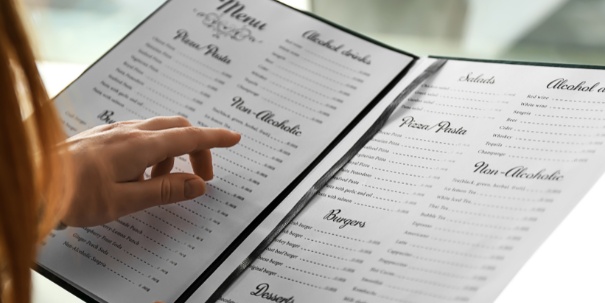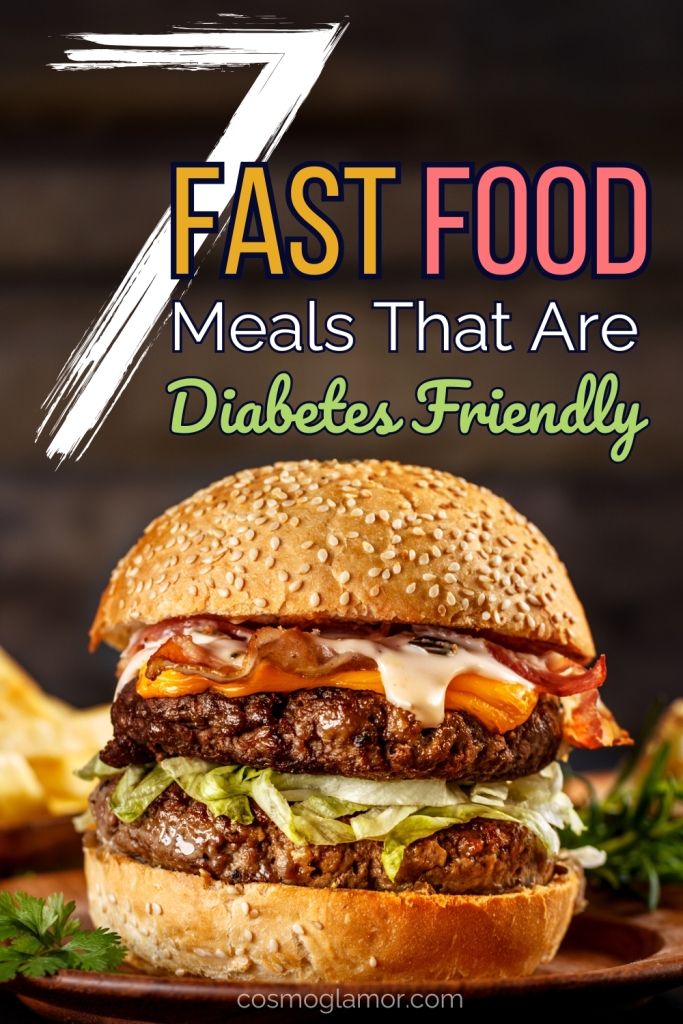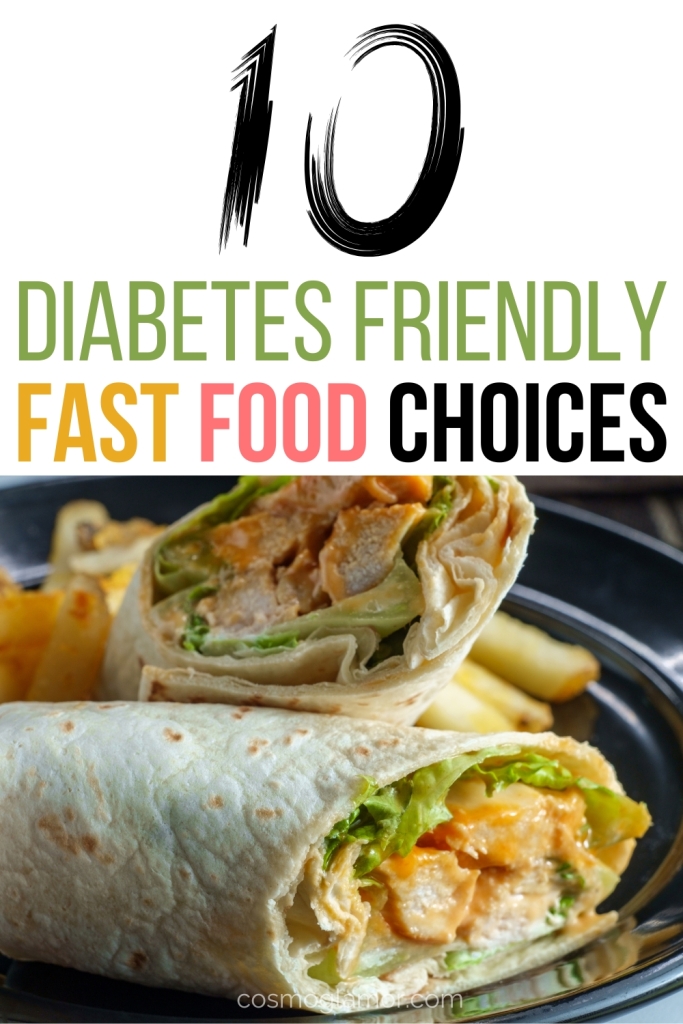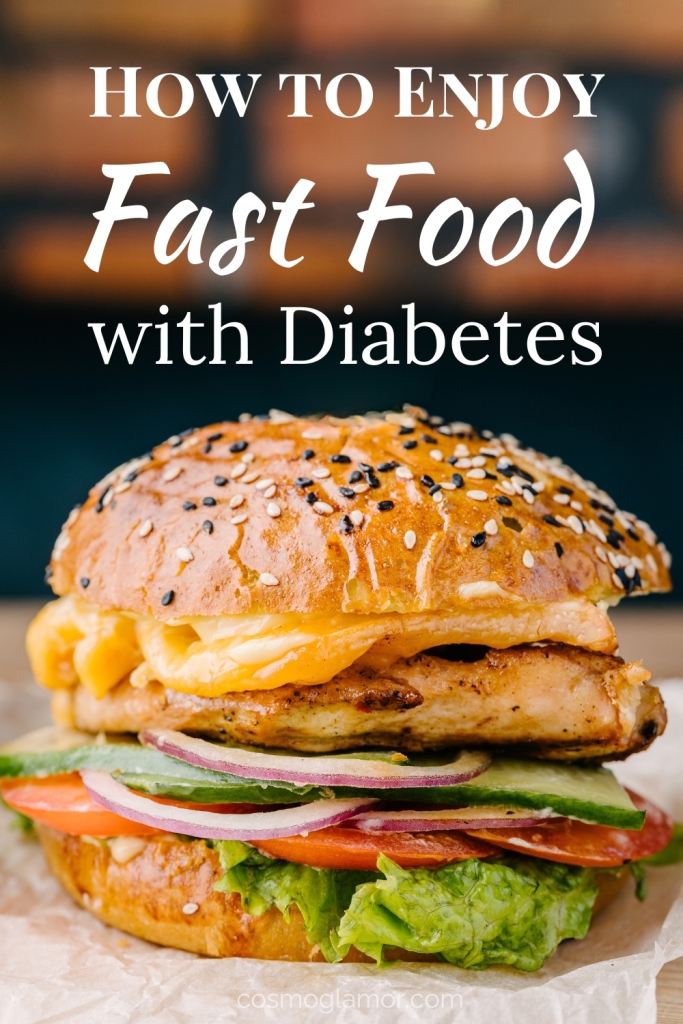I’ve been there. It’s 6 PM, the kids are hungry (and loud), Mark is stuck in traffic, and the last thing on my mind is cooking a full meal. The drive-thru is calling.
When I was first diagnosed with Type 2 Diabetes, I thought these days were over. I pictured myself stuck with a sad bag of baby carrots while my family ate burgers. The fast-food menu felt like a minefield of sugar, sodium, and processed carbs.
But here’s the deal: living with diabetes doesn’t mean you’re banned from convenience. It just means you need a game plan.
You absolutely can find fast food for diabetics, but it requires a little strategy. This guide is my personal playbook for navigating American fast-food menus without sending my blood sugar on a rollercoaster.
Can Diabetics Even Eat Fast Food?

Let’s get this out of the way: Yes. But it’s all about how you do it.
Is fast food the healthiest choice? No. Should it be an everyday thing? Definitely not. But for those crazy days, it’s a “better-than-starving” option. The goal is to make the smartest choice available.
The challenge with fast food is that it’s often packed with refined carbs, unhealthy fats, and sky-high sodium—all things we need to manage carefully. But with a plan, you can navigate the menu and find options that work.
It’s about making a few simple swaps to support your blood sugar goals. This is just one part of a bigger strategy for enjoying eating out worry-free.
Your 5-Step “Fast Food for Diabetics” Game Plan

Over the years, I’ve developed a 5-step checklist I run through mentally. This is how to eat fast food with diabetes and stay in control.
Step 1: Do a 2-Minute Check (Before You Go)
My researcher background kicks in here. Knowledge is power.
Almost every major chain (McDonald’s, Wendy’s, Taco Bell, etc.) posts its nutritional information online or in its app. Before I even leave the house, I take two minutes to look it up.[5]
I’m not looking for calories. I’m looking for:
- Total Carbohydrates: This is my primary number.
- Fiber: More fiber is better! It helps slow down sugar absorption. [1]
- Protein: This will help me feel full and balance the meal. [2]
This quick check helps me identify 2-3 “safe” options before I’m even at the speaker box, so I don’t panic-order.
Step 2: Skip the Sugary Drinks (The Easiest Win)
This is non-negotiable. A large regular soda can pack 40-60 grams of pure sugar. That’s liquid sugar that will hit your bloodstream like a freight train. [4]
Your best choices are:
- Water
- Unsweetened Iced Tea
- Diet Soda (in moderation, if it’s your only option)
Skipping the soda is the single fastest way to cut 100% of the liquid sugar from your meal. [3]
Step 3: Learn to “Hack” the Menu
This is where you spot the hidden traps. Here are my go-to rules for ordering.
Go Grilled, Not Fried
This is the golden rule of diabetic fast food options. “Crispy,” “crunchy,” or “breaded” means it’s covered in refined-carb breading and deep-fried. Always choose grilled chicken over a fried chicken patty. A grilled chicken sandwich or grilled nuggets are almost always a better bet. [6]
Beware of Sauces and Dressings
This is where they get you! Ketchup, BBQ sauce, honey mustard, and “special sauces” are loaded with hidden sugars. A single packet of BBQ sauce can have 10+ grams of carbs.
My fix: Ask for sauce on the side or skip it. Use plain mustard, hot sauce, or a light vinaigrette for salads.
Mind Your Buns (and Wraps)
A giant, fluffy white-bread bun is a huge carb load. You don’t always have to eat it all. Sometimes I’ll just eat the sandwich “open-faced” and ditch the top bun. If you’re getting a bowl, think hard about the rice. If you’re really craving bread, at least know what kind of bread is best (though you won’t often find it here).
Step 4: Control Your Portions (Avoid the “Value” Trap)
“Super-sizing” is a terrible deal for your health. Those value meals are designed to give you more carbs and sugar for just a little more money.
- Never “super-size.” Ever.
- Order a-la-carte. Just get the sandwich, not the meal.
- Get the Kid’s Meal. I’m serious! The portion is often perfect.
- Skip the fries. If you absolutely must have them, get the smallest size possible and share it. A better side is often a side salad or apple slices.
Portion size matters—a lot. Larger portions reliably increase how much we eat. [7]
Step 5: Build a Balanced Plate
Your goal is to get a mix of protein, healthy fat, and fiber. This is the magic combo that helps slow down carb digestion. [11]
- Protein: Grilled chicken breast, a single burger patty.
- Fiber/Veggies: A side salad, lettuce/tomato on your sandwich, or fajita veggies in a bowl.
- Carb: Half the bun, a small order of beans, or a kid’s size fry.
Notice you’re getting all three, but in smarter proportions. We’re aiming for balance, not perfection.
Smart Diabetic Fast Food Options (Examples)

So, what can a diabetic eat at a fast food place? Here are some of my “go-to” orders in a pinch.
[Image: An infographic comparing a “Smarter Choice” meal (Grilled Chicken Salad with Water) next to a “Tougher Choice” meal (Fried Chicken Sandwich, Large Fries, and Soda) showing the carb and sugar difference.]
At a Burger Place (like Wendy’s or McDonald’s)
- Smarter Choice: A single patty hamburger or cheeseburger. Ask for extra lettuce and tomato. Ditch half the bun. Get a side salad with vinaigrette or a small chili (at Wendy’s).
- Avoid: Double/triple burgers, bacon-loaded burgers, milkshakes, and large fries.
At a Chicken Place (like Chick-fil-A)
- Smarter Choice: Grilled Chicken Sandwich (watch the sauce – a little mayo is better than honey mustard) or Grilled Nuggets. Get a side salad or the kale crunch salad.
- Avoid: Fried/crispy sandwiches, creamy sauces (like ranch), coleslaw (often high in sugar), and waffle fries.
At a Mexican-Style Grill (like Chipotle)
- Smarter Choice: A salad bowl or burrito bowl. Load up on protein (chicken, steak), fajita veggies, and salsa. Get a small scoop of black beans and/or brown rice, or skip them and add guacamole for healthy fat.
- Avoid: The giant tortilla burrito, white rice, chips, and queso.
A Quick Word on Safety (My Guardrail)
Here’s the final, important piece of advice: fast food is a “sometimes” food for a reason.
Even the “healthy” options are often loaded with sodium. As someone who also manages high blood pressure, this is a big deal for me. Too much sodium isn’t good for our hearts. [8] [9]
Most importantly, everyone’s body is different. A meal that works for me might still spike your blood sugar. The best way to know is to test your blood sugar about 1-2 hours after you eat. That’s the real data you need. [10]
When in doubt, take a screenshot of the nutrition info and show it to your doctor or a registered dietitian. They can help you create a personalized plan.
My Final Takeaway
Living with diabetes in a fast-food world isn’t about restriction—it’s about strategy. You don’t have to live in fear of the drive-thru.
By checking nutrition info, skipping sugary drinks, choosing grilled over fried, watching your portions, and being mindful of sugary sauces, you can make it work on those crazy-busy days.
If you found this helpful, you might also love my guide on 3 Simple Tricks to Help Balance Blood Sugar After Eating Carbs.
Disclaimer: This article is for informational and educational purposes only, based on my personal research and experience. It does not constitute medical advice. Always consult with your doctor or a qualified healthcare provider before making any significant changes to your diet or health routine.
References
- Silva FM et al. Fiber intake and glycemic control in type 2 diabetes: systematic review and meta-analysis (2013). ↩︎ Back to text
- Leidy HJ et al. The role of protein in satiety, energetics, weight loss and health (2015). ↩︎ Back to text
- American Diabetes Association. Nutrition for Life: Sugar Substitutes—avoid sugary drinks; choose water, diet soda, or unsweetened tea (2023). ↩︎ Back to text
- Imamura F et al. Consumption of sugar-sweetened beverages and incidence of type 2 diabetes: systematic review and meta-analysis (2015). ↩︎ Back to text
- U.S. FDA. Menu Labeling Requirements—calories on menus; additional written nutrition info upon request (carbohydrates, sugars, fiber, protein, etc.) (2023). ↩︎ Back to text
- Dangal A et al. Review on deep-fat fried foods: physical, chemical and nutritional changes; fat uptake mechanisms (2024). ↩︎ Back to text
- Rolls BJ et al. Reductions in portion size and energy density reduce energy intake (2006). ↩︎ Back to text
- Johnson CM et al. Sodium content of lunchtime fast food purchases at major U.S. chains (2010). ↩︎ Back to text
- ADA Standards of Care 2024—counsel people with diabetes to limit sodium to <2,300 mg/day. ↩︎ Back to text
- American Diabetes Association. Checking Your Blood Sugar—test 1–2 hours after beginning a meal; target <180 mg/dL (most adults). ↩︎ Back to text
- Lejk A et al. Effects of different types of meals on postprandial glycemia—combining carbohydrates with protein lowers glycemic response (2024). ↩︎ Back to text








12 Responses
This is such a helpful guide! I’m a nurse with type 2 diabetes, and I often have to grab food on the go between shifts. I’m honestly surprised that the Egg McMuffin is on the ‘okay’ list – I always thought they were a no-no. Is it really okay to eat the whole thing, English muffin and all? Also, I’ve heard that some places will do lettuce wraps instead of buns, but I always feel awkward asking. Do you have any tips for making those special requests without feeling like a total pain in the you-know-what?
Hi Deborah! Thanks for the kind words! I’m glad you found it helpful. Yes, the Egg McMuffin can be a decent choice, especially if you skip the Canadian bacon. The whole thing, English muffin included, provides a reasonable balance of protein and carbs. But of course, listen to your body and monitor your blood sugar to see how it affects you. As for special requests, don’t feel awkward at all! Most places are used to it these days. Just be polite and clear about what you need. You can say something like, ‘Could I please have that burger with a lettuce wrap instead of a bun?’ It also helps to know they offer it ahead of time. It’s all about advocating for your health, and any decent restaurant will understand that!
Okay, I’ll admit it, I love fast food. But my doctor’s been nagging me about my blood sugar, so I guess I need to make some changes. This article is a good start, but I have a major weakness for milkshakes. Are there ANY fast-food milkshakes that aren’t a total sugar disaster? Also, what about those ‘healthy’ fast-food places like Chipotle or Panera? Are they really any better, or is it just a marketing trick? And one last thing – your article mentions bringing your own seasoning for low sodium. What kind of seasoning do you recommend?
Hi Melissa! I hear you – the siren call of milkshakes is strong! Unfortunately, most fast-food milkshakes are sugar bombs. Your best bet is probably a small size and to consider it a rare treat. Some places might offer a “light” or “no sugar added” version, but always check the nutrition info. As for places like Chipotle and Panera, they can be healthier options, but it still depends on what you order. They tend to use fresher ingredients, but portion sizes can still be large, and some of their sauces and dressings can be high in sugar and sodium. So, the same rules apply – be mindful of your choices! Regarding seasonings, I love Mrs. Dash or any salt-free blend. There are lots of great options out there with different flavor profiles – garlic and herb, lemon pepper, even spicy ones! Experiment and find what you like best. Hope this helps!
This article is a lifesaver! I’m always on the road for work, and figuring out what to eat at fast-food places has been a real struggle since my Type 2 diagnosis. I had no idea you could order things “Fresco Style” at Taco Bell – that’s a game-changer! But I’m a bit confused about the whole “glycemic index” thing. The article mentions it, but doesn’t really explain it. Is it something I should be paying attention to, and how does it relate to carb counting? Also, is diet soda really okay? I’ve heard mixed things. LOL, I don’t want to make a bad situation worse.
Hi Ava! I’m so glad you found the article helpful! It’s definitely tricky navigating fast food with diabetes, but it’s totally doable. You’re right, the glycemic index (GI) can be a bit confusing. Basically, it’s a ranking of how quickly different carbohydrate-containing foods raise your blood sugar levels. Foods with a high GI cause a rapid spike, while low GI foods have a slower, gentler effect. It’s something to consider, especially if you’re trying to manage your blood sugar closely. It’s related to carb counting, but they’re not exactly the same. Carb counting focuses on the total amount of carbs, while GI considers the quality of those carbs. As for diet soda, it’s generally a better choice than regular soda because it doesn’t have sugar. However, there’s some debate about the long-term effects of artificial sweeteners. Water or unsweetened tea are still the best options, but an occasional diet soda is probably fine. Hope that clears things up!
Okay, this is all great in theory, but let’s be real. Sometimes you’re just starving and you pull into the first fast-food place you see. There’s no time for researching menus and nutritional info! Plus, I travel to different states all of the time, and not all fast food places have the same menu. I need some advice for those “emergency” situations. Also, are any of these places actually good? I’m sacrificing enough with my diet as it is. LOL! Also, what’s the deal with those “healthy” fast-food salads? They always seem like a safe bet, but are they really?
Hi Léa! You’re absolutely right – sometimes you just need to grab something quick! In those “emergency” situations, I’d say your best bet is to stick with the basics: grilled chicken (sandwich, hold the bun, or a salad), a side salad, or even just a plain burger without the bun. Most places have these options, even if the menus vary. As for whether these places are “good” – well, taste is subjective, but many people find that grilled options with some added veggies can be surprisingly satisfying! And you’re smart to question those “healthy” salads! They can be a trap if they’re loaded with high-calorie dressings, croutons, and cheese. Always check the nutritional info if you can, or ask for dressing on the side and use it sparingly. I would also recommend that you do some research on fast food places in the states that you frequent the most. This way, you have a list of go-to places and meals that you can rely on. It will take some time, but it will help you in those emergency situations.
Okay, this is helpful, but let’s be real. Sometimes, the siren song of the McFlurry is just too strong. Is there any way to indulge occasionally without completely derailing my blood sugar? Like, a “once-a-month McFlurry survival guide” maybe?
Lucía, I feel you! The McFlurry temptation is real. While I can’t endorse a daily McFlurry habit, a monthly indulgence isn’t the end of the world. The key is damage control. First, choose the smallest size. Second, be extra mindful of your carbs for the rest of the day – maybe skip the fries with your burger (if you’re having one!). Third, and this is crucial, enjoy it mindfully. Savor every spoonful. The guilt-free enjoyment might actually help you from overdoing it. And hey, maybe consider a “light” McFlurry version, if available, or even better, a fruit parfait. It’s all about making informed choices and enjoying in moderation!
This article is great, but what about those late-night cravings? Like, it’s 11 PM, you’re driving home, and the only thing open is a 24-hour drive-thru. Are there any healthy options at that hour, or am I doomed to a blood sugar rollercoaster all night? Seriously, this is a real-life dilemma.
Carolyn, late-night cravings are the ultimate test of willpower! You’re right, options are limited at that hour. Your best bet is to plan ahead. Keep some healthy snacks in your car or at home for those late-night emergencies – a handful of nuts, a protein bar, or even some pre-cut veggies. If you absolutely must hit the drive-thru, look for grilled chicken nuggets (not the breaded ones!), a side salad with a light vinaigrette, or even just a plain hamburger (ditch the bun and toppings). Water is your best friend at this hour. Avoid sugary drinks and fries at all costs. It’s all about making the best of a tough situation and remembering that your health is worth it!